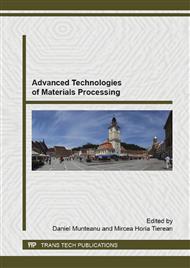[1]
J. Yu, Z. Ren, W. Ren, K. Deng, Y. Zhong, Solidification structure of eutectic Al-Si alloy under a high magnetic field-aid-electromagnetic vibration, Acta Metall. Sin. 22 (2009) 191-196.
DOI: 10.1016/s1006-7191(08)60088-5
Google Scholar
[2]
N. Omura, Y. Murakami, M. Li, T. Tamura, K. Miwa, H. Furukawa, M. Harada, Effects of Mechanical Vibration on Cooling Rate and DAS of AC4C Aluminum Alloy Gravity Die Castings, Materials Transactions 50 (2009) 2604-2608.
DOI: 10.2320/matertrans.m2009247
Google Scholar
[3]
N. Omura, Y. Murakami, M. Li, T. Tamura, K. Miwa, H. Furukawa, M. Harada, M. Yokoi, Effects of Mechanical Vibration on Macrostructure and Mechanical Properties of AC4C Aluminum Alloy Castings, Materials Transactions 50 (2009) 2578-2583.
DOI: 10.2320/matertrans.f-m2009822
Google Scholar
[4]
M.A. Suareza, I. Figueroab, A. Cruza, A. Hernandeza, J.F. Chavez, Study of the Al-Si-X System by Different Cooling Rates and Heat Treatment, Materials Research 15 (2012) 763-769.
Google Scholar
[5]
P. Appendini, G. Crillevone, C. Mus, S. Spriano, Dynamic solidification of sand-cast aluminium alloys, Metallurgical Science and Technology 20 (2002) 27-32.
Google Scholar
[6]
M. Khraisheh, K. Saito, A. Male, Silicon morphology modification in the eutectic Al–Si alloy using mechanical mould vibration, Materials Science and Engineering A (2005) 109-117.
DOI: 10.1016/j.msea.2004.09.038
Google Scholar
[7]
X. Jian, T.T. Meek, Q. Han, Refinement of eutectic silicon phase of aluminum A356 alloy using high-intensity ultrasonic vibration, Scripta Materialia 54 (2006) 893–896.
DOI: 10.1016/j.scriptamat.2005.11.004
Google Scholar
[8]
R. Kumar, Md. S. Ansari, S.S. Mishra, A. Kumar, Effect of Mould Vibration on Microstructure and Mechanical Properties of Casting During Solidification, International Journal of Engineering Research & Technology 3 (2014) 90-92.
Google Scholar
[9]
S. Gnapowski, Y. Tsunekawa, M. Okumiya, K. Lenik, Change of Aluminum Alloys Structure by Sono-Solidification Archives of Foundry Engineering 13 (2013) 39-42.
DOI: 10.2478/afe-2013-0078
Google Scholar
[10]
K. Kocatepe, C.F. Burdett, Effect of low frequency vibration on macro and micro structures of LM6 alloys, Journal of Materials Science 35 (2000) 3327-3335.
Google Scholar
[11]
S. Shivkumar, L. Wang, D. Apelian, Molten Metal Processing of Advanced Cast Aluminium Alloys, JOM 1 (1991) 26-33.
DOI: 10.1007/bf03220114
Google Scholar


